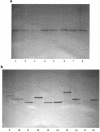Effect of tetracycline on transfer and establishment of the tetracycline-inducible conjugative transposon Tn916 in the guts of gnotobiotic rats
- PMID: 14766552
- PMCID: PMC348894
- DOI: 10.1128/AEM.70.2.758-764.2004
Effect of tetracycline on transfer and establishment of the tetracycline-inducible conjugative transposon Tn916 in the guts of gnotobiotic rats
Abstract
We have investigated the transfer of Tn916 among strains of Enterococcus faecalis OG1 colonizing in the intestines of gnotobiotic rats. This animal model allows a low limit of detection and efficient colonization of the chosen bacteria. The animals continuously received tetracycline in drinking water. A tetracycline-sensitive recipient strain was allowed to colonize the animals before the resistant donor was introduced. The numbers of donors, recipients, and transconjugants in fecal samples and intestinal segments were estimated. The bioavailable amounts of tetracycline in fecal samples and intestinal segments were monitored by using bacterial biosensors carrying a transcriptional fusion of a tetracycline-regulated promoter and a lacZ reporter gene. Chromosomal locations of Tn916 in transconjugants isolated either from the same animal or from different animals were compared by Southern blot analysis. Our results indicated that selection for the resistant phenotype was the major factor causing higher numbers of transconjugants in the presence of tetracycline. Tetracycline-sensitive E. faecalis cells colonized the intestine even when the concentrations of tetracycline in feces and intestinal luminal contents exceeded growth-inhibitory concentrations. This suggests the existence of tetracycline-depleted microhabitats in the intestinal environment.
Figures



References
-
- Agersø, Y., L. B. Jensen, M. Givskov, and M. C. Roberts. 2002. The identification of a tetracycline resistance gene tet(M), on a Tn916-like transposon, in the Bacillus cereus group. FEMS Microbiol. Lett. 214:251-256. - PubMed
-
- Andrup, L., and K. Andersen. 1999. A comparison of the kinetics of plasmid transfer in the conjugation systems encoded by the F plasmid from Escherichia coli and plasmid pCF10 from Enterococcus faecalis. Microbiology 145:2001-2009. - PubMed
-
- Celli, J., and P. Trieu-Cuot. 1998. Circularization of Tn916 is required for expression of the transposon-encoded transfer functions: characterization of long tetracycline-inducible transcripts reading through the attachment site. Mol. Microbiol. 28:103-117. - PubMed
-
- Clewell, D. B., S. E. Flannagan, and D. D. Jaworski. 1995. Unconstrained bacterial promiscuity: the Tn916-Tn1545 family of conjugative transposons. Trends Microbiol. 3:229-236. - PubMed
-
- Costerton, J. W., P. S. Stewart, and E. P. Greenberg. 1999. Bacterial biofilms: a common cause of persistent infections. Science 284:1318-1322. - PubMed
Publication types
MeSH terms
Substances
LinkOut - more resources
Full Text Sources
Medical

